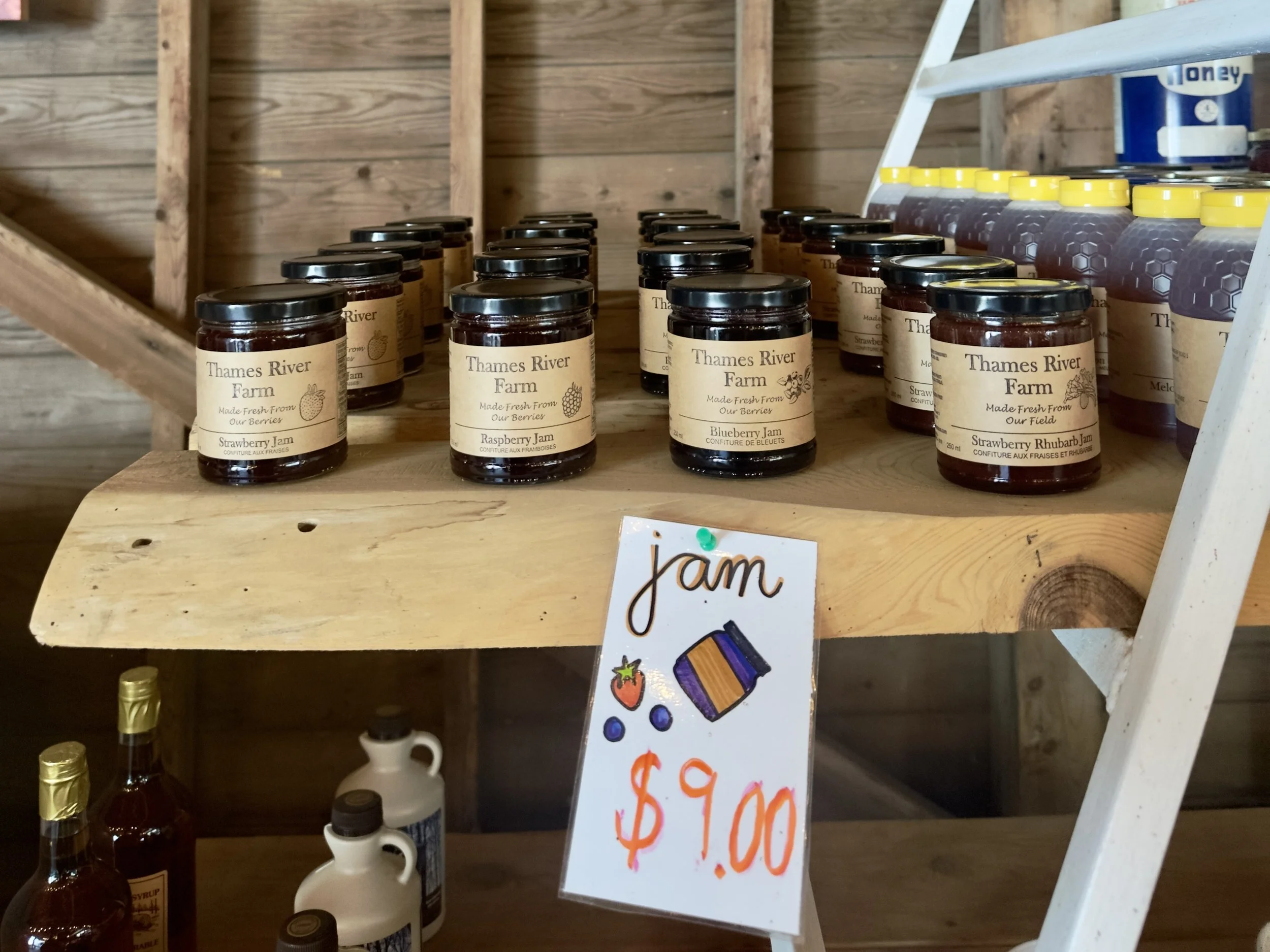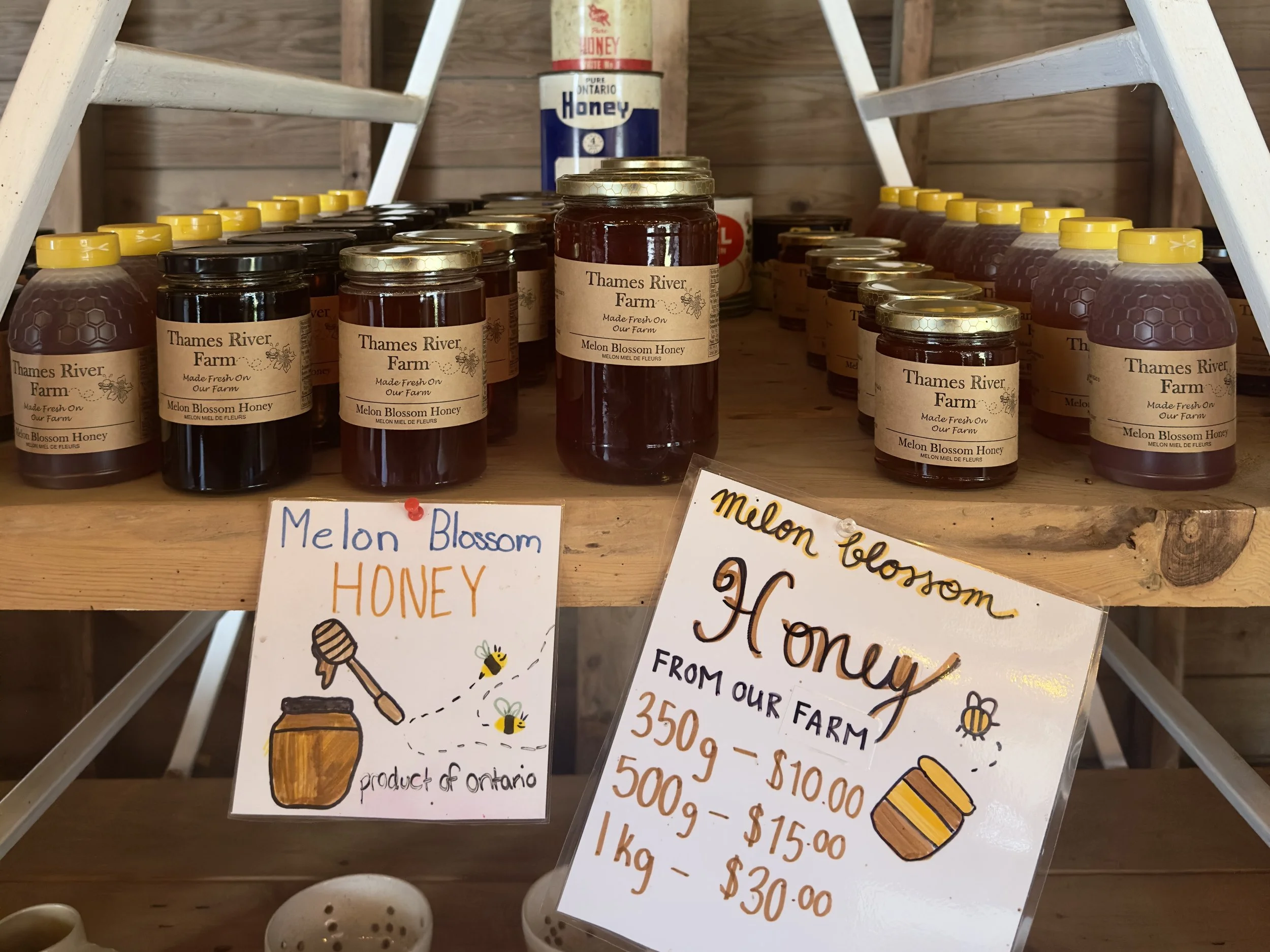Hi everyone! We’re Alex and Angelique, two Master’s students specializing in Dietetics (aka: food and nutrition). If you’ve visited the farm recently, there’s a good chance you’ve seen us out and about chatting with folks about food, farming, and all things nutrition.
During these chats, one question kept popping up again and again: “Should I be worried about the sugar in fruits, jams, jellies, and other preserves?”.
We love this question for many reasons, but a big one is because there’s so much conflicting information out there about this topic. It causes a lot of confusion and unnecessary fear, especially when it comes to the sweet, seasonal foods we all enjoy.
So, think of this as a “back to the basics”, where we’ll break down the science to help you understand how to enjoy your favorite fruity foods while nourishing your body. Before we start, one small disclaimer: this information is for educational purposes and is general enough that it can apply to both those with a condition that impacts sugar metabolism and normal sugar metabolizing folks alike. That being said, nothing you read online should replace individualized care recommendations from your health care team, so take what fits and leave the rest!
Let’s dive in!
It seems like every time we open our phone, turn on the TV, listen to the radio, or even have conversations with friends and family, everyone has an opinion about sugar. Limit this, don’t eat that, fruits are bad, fruits are good, just cut out sugar completely! The list goes on… But the reality is, sugar is a necessary part of our diet, to keep our brains functional. The conversation shouldn’t be about avoiding sugar altogether, but rather it should be about understanding how to enjoy it safely and confidently!
We talk about this much more over in our Nutrition Hub but our bodies ultimately break down even the most stereotypically “healthy” foods into simple sugars to keep our basic functions going. Think of these foods like a chain linked together, and every time our body breaks off a link of the chain, it releases some energy needed to survive. If the chain is strong, we are going to break it apart one link at a time, with a gradual release of that energy. If the chain is weak, then we break it apart all at once, giving a quick burst of energy that can often leave us feeling not so great. So, how can we make the chain stronger? Protein and fibre!
Protein and fibre make the chain stronger. These two components require a lot of energy to break apart in order to access the fuel (aka glucose). If your body is focused on breaking apart these components, it’s harder for the sugar you eat to spike your blood sugar. Clinical research trials found that eating something high in protein before something high in sugar will lower blood sugar spikes. This observation has been repeated so many times that the idea of pairing protein with high sugar, (aka high carbohydrate) foods is encouraged by Diabetes Canada. Fibre, especially soluble fibre (the type that forms a gel, commonly found in fruits, chia seeds, and oatmeal) can actually slow down the speed that our body takes sugar into the blood while digesting it. Insoluble fibre (the kind found in vegetables and grains to make up their “bulk”) is known to improve insulin resistance over time when consumed regularly. Insulin is like the key unlocking the door to let sugar into our cells so we can use it as the energy we need. If we improve insulin resistance, it means that our bodies are going to react to insulin the way it is supposed to, not “resisting” its unlocking effect. This means we will have steadier blood sugar levels even if we eat foods with sugar! Pretty cool huh?
Now that we’ve broken down the science, let's chat about what this looks like when it comes to your everyday food choices. Throughout this section, our hope is that you can see that balance is more important than restriction.
Many of the farm visitors we spoke with expressed how much they love preserving the berries they pick into delicious jams and jellies. But, they don’t feel like they can eat these items anymore because of the sugar content. Taking what we’ve learned above, here are a few ideas for eating the delicious preserves without spiking your blood sugar:
Try a simple snack of your homemade jam on some wholegrain toast, with some high protein yogurt on the side!
Not your thing?
Try some oats, chia seeds, your jam and a hard-boiled egg with eggs from our chickens!
Make a delicious berry crumble, but use a sugar alternative in the crumble like stevia, with a variety of seeds to add more fibre. When enjoying this, try some vanilla high protein yogurt as a swap for the ice cream. Or, have a scoop of your favorite ice cream with your crumble and a protein shake.
Noticing a trend here? Good! That brings us to the idea of building your plate strategically to enjoy your favorite foods without a burst of sugar. Remember the goal, balance not restriction! When enjoying anything that’s high in sugar, try building your plate so that you have something high in protein and something high in fibre to eat along with the higher sugar foods.
Food labels are a great tool to help you understand where to be strategic. When we look at a food label, Health Canada shows us the “percent daily values”. Health Canada has also created the easy to memorize tagline: “5% is a little, 15% is a lot”. This is a great tool for knowing when to pair your foods with protein and fibre. Think about it like this, if the label shows a sugar content above the 5% daily value cutoff for it being “a little”, pair it with protein and fibre! Additionally, the ingredients list is a good indicator for pairing foods with protein and fibre. Ingredients are listed in order, from most to least by weight. This means that the first ingredients listed are what there is the most of, and the last ingredients are what there’s the least of. So once again, if you see sugar as one of the first ingredients, pair it with protein and fibre!
You’ve made it to the end! Congratulations. We really hope that this blog post has given you the confidence to eat foods that have sugar in them, without being afraid. Remember, sugar has a place in a balanced diet. It's much more important to consider what you pair the sugar-forward items with, and how these delicious items fit into the bigger picture of your food choices over time. Get curious and try combinations of protein and fibre to see what feels best with your body. Don’t feel guilty for enjoying these delicious foods. And if you see us (Angelique and Alex) around the farm, come say hi and let us know how you’ve tried putting this into practice!
Sources:
Diabetes Canada. (2024). Protein and Diabetes: What You Need to Know . Toronto, ON; Diabetes Canada.
Song, J., Oh, T. J., & Song, Y. (2023). Individual postprandial glycemic responses to meal types by different carbohydrate levels and their associations with glycemic variability using continuous glucose monitoring. Nutrients, 15(16), 3571. https://doi.org/10.3390/nu15163571
Bae, J. H., Kim, L. K., Min, S. H., Ahn, C. H., & Cho, Y. M. (2018). Postprandial glucose‐lowering effect of premeal consumption of protein‐enriched, dietary fiber‐fortified bar in individuals with type 2 diabetes mellitus or normal glucose tolerance. Journal of Diabetes Investigation, 9(5), 1110–1118. https://doi.org/10.1111/jdi.12831
Weickert, M. O., & Pfeiffer, A. F. (2018). Impact of dietary fiber consumption on insulin resistance and the prevention of type 2 diabetes. The Journal of Nutrition, 148(1), 7–12. https://doi.org/10.1093/jn/nxx008







